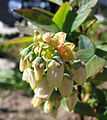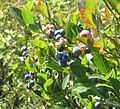Vaccinium corymbosum
| Vaccinium corymbosum Northern Highbush Blueberry | |
|---|---|
.jpg) | |
| Scientific classification | |
| Kingdom: | Plantae |
| (unranked): | Angiosperms |
| (unranked): | Eudicots |
| (unranked): | Asterids |
| Order: | Ericales |
| Family: | Ericaceae |
| Genus: | Vaccinium |
| Species: | V. corymbosum |
| Binomial name | |
| Vaccinium corymbosum L. | |
| Part of a series on |
| American cuisine |
|---|
|
Regional cuisines |
|
Ingredients and foods
|
|
Ethnic and cultural |
|
Holidays and festivals |
|
Vaccinium corymbosum, the northern highbush blueberry, is a species of blueberry native to eastern North America, from the Great Lakes region east to Nova Scotia, and south through the Northeastern United States and Appalachian region, to the Southeastern United States in Mississippi.[1][2] Other common names include blue huckleberry, tall huckleberry, swamp huckleberry, high blueberry, and swamp blueberry.[3]
Description
Vaccinium corymbosum is a deciduous shrub growing to 6–12 feet (1.8–3.7 m) tall and wide. It is often found in dense thickets. The dark glossy green leaves are elliptical and up to 5 centimetres (2.0 in) long. In autumn, the leaves turn to a brilliant red, orange, yellow, and/or purple.[2]
The flowers are long bell or urn-shaped white to very light pink, 0.33 inches (8.4 mm) long.[2]
The fruit is a 0.25–0.5 inches (6.4–12.7 mm) diameter blue-black berry.[2] This plant is found in wooded or open areas with moist acidic soils.[4]
Cultivation
These berries were collected and used in Native American cuisine in areas where V. corymbosum grew as a native plant.[5] This plant is also the most common commercially grown blueberry in present day North America.
It is also cultivated as an ornamental plant for home and wildlife gardens and natural landscaping projects.[4][6] The pH must be very acidic (4.5 to 5.5).[2] In natural habitats it is a food source for native and migrating birds, bears, and small mammals.
Outside of its natural range in North America, Vaccinium corymbosum has naturalized in British Columbia and the U.S. state of Washington.[7] On other continents it has naturalized in Japan, New Zealand, Great Britain, Poland, and the Netherlands.[7]
Cultivars
Some common cultivar varieties are listed here, grouped by approximate start of the harvest season:[8]
|
|
|
The cultivars Duke[9] and Spartan[10] have gained the Royal Horticultural Society's Award of Garden Merit.
Southern highbush blueberry
Some named southern highbush blueberries are hybridized forms derived from crosses between V. corymbosum and Vaccinium darrowii, a native of the Southeastern U.S. These hybrids and other cultivars of V. darrowii (Southern highbush blueberry) have been developed for cultivation in warm southern and western regions of North America.[11][12]
Gallery
-

Mature shrub.
-

Young shrub with fruit.
-

Foliage
-

Flowers
-

Berries, ripe and unripe.
-

Berry closeup
See also
References
- ↑ Taxonomic account from Integrated Taxonomic Information System (ITIS) — for Vaccinium corymbosum (highbush blueberry)
- ↑ 2.0 2.1 2.2 2.3 2.4 Hort.uconn.edu: Vaccinium corymbosum . accessed 3.23.2013
- ↑ Gough, Robert Edward (1994). The highbush blueberry and its management. Psychology Press. p. 3. ISBN 978-1-56022-021-3. Retrieved 2011-04-29.
- ↑ 4.0 4.1 Missouri Botanical Garden: Kemper Center for Home Gardening — Vaccinium corymbosum . accessed 3.23.2013
- ↑ University of Michigan: Dearborn — Native American Ethnobotany (Vaccinium corymbosum) . accessed 3.23.2013
- ↑ Hort.uconn.edu: Vaccinium corymbosum; Landscape use section . accessed 3.23.2013
- ↑ 7.0 7.1 GRIN . accessed 3.23.2013
- ↑ Hort.uconn.edu: Vaccinium corymbosum; Cultivars/varieties section . accessed 3.23.2013
- ↑ "RHS Plant Selector - Vaccinium corymbosum 'Duke'". Retrieved 16 July 2013.
- ↑ "RHS Plant Selector - Vaccinium corymbosum 'Spartan'". Retrieved 16 July 2013.
- ↑ eXtension: Southern Highbush Blueberry Varieties
- ↑ Four Winds Growers: Care of southern highbush blueberries
External links
| Wikimedia Commons has media related to Vaccinium corymbosum. |